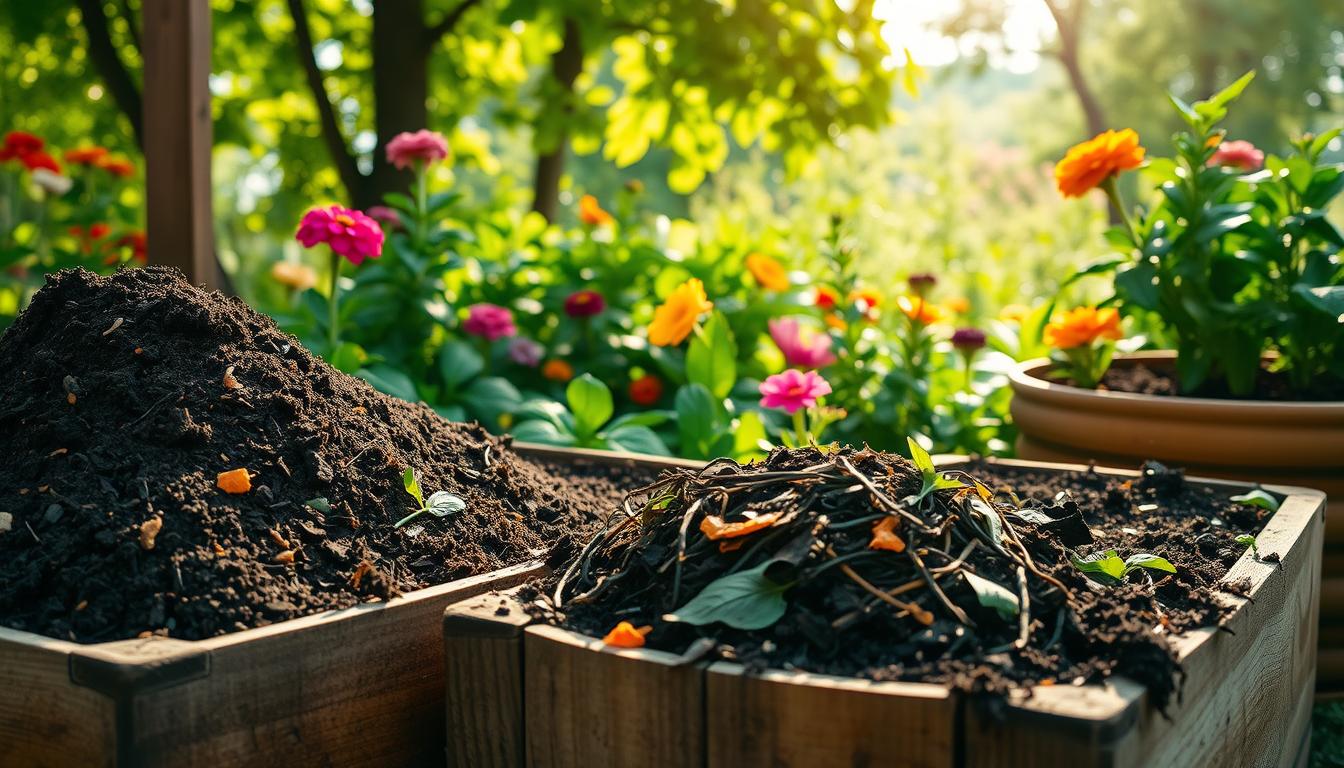As a gardener, I’ve found that DIY soil amendments are cost-effective and eco-friendly. They help improve soil health. I’ve turned my garden into a thriving oasis by making my own homemade soil conditioners. I’ll share my experience and the benefits of using organic and natural ingredients.
Creating my own DIY soil amendments has saved me money and given me control over the ingredients. I avoid harsh chemicals and artificial additives. Instead, I use organic additives that boost microbial activity and nutrient uptake.
There are many DIY soil amendments like compost, worm castings, coffee grounds, and leaf mold. They can all improve soil health. In the next sections, I’ll explain how to make and use them. I hope to inspire you to make your own DIY soil amendments and enjoy healthy, thriving soil.
Why I Decided to Make My Own Soil Amendments
I wanted to control what goes into my garden. So, I started making my own soil amendments. This way, I avoid harsh chemicals and follow DIY gardening tips. It’s rewarding and saves money.
Understanding Soil Health
Soil health is key for a healthy garden. DIY amendments let me tailor my soil to my plants’ needs. I add compost to improve structure and fertility.
The Benefits of DIY Amendments
DIY amendments save money, help the environment, and boost plant health. The benefits include:
- Improved soil fertility
- Increased plant growth and yields
- Reduced environmental impact
Cost Savings
By making my own amendments, I save on gardening supplies. I also use materials like food scraps and leaves that would otherwise be wasted.
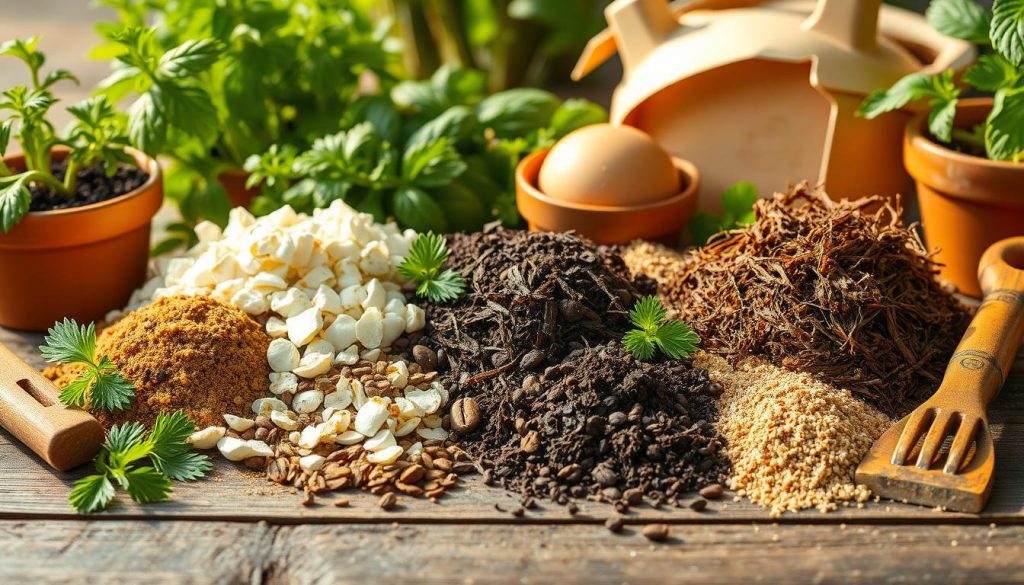
Common Ingredients for Soil Amendments
Exploring DIY soil amendments, I found many common ingredients. These not only add nutrients to the soil but also save money. Using them has greatly improved my garden, and I’m eager to share this with you.
Effective ingredients include compost, worm castings, and coffee grounds. You can use them alone or together for a nutrient-rich mix. For instance, compost comes from kitchen scraps and yard waste. Worm castings are from vermicomposting, and coffee grounds add nitrogen to the soil.
Compost: My Go-To Ingredient
Compost is essential in my garden. It’s full of nutrients, improves soil structure, and boosts microbial life. Adding compost to my soil has greatly helped my plants grow and stay healthy.
Worm Castings: The Nutrient Powerhouse
Worm castings, or vermicompost, are packed with nutrients. They’re great for improving plant growth and yields. I’ve seen amazing results in my garden with worm castings, and I recommend them highly.
Coffee Grounds: An Unexpected Boost
Coffee grounds are a surprising addition to soil amendments. They’re full of nitrogen, phosphorus, and potassium. Adding them to my compost or soil has given my plants a surprising boost.
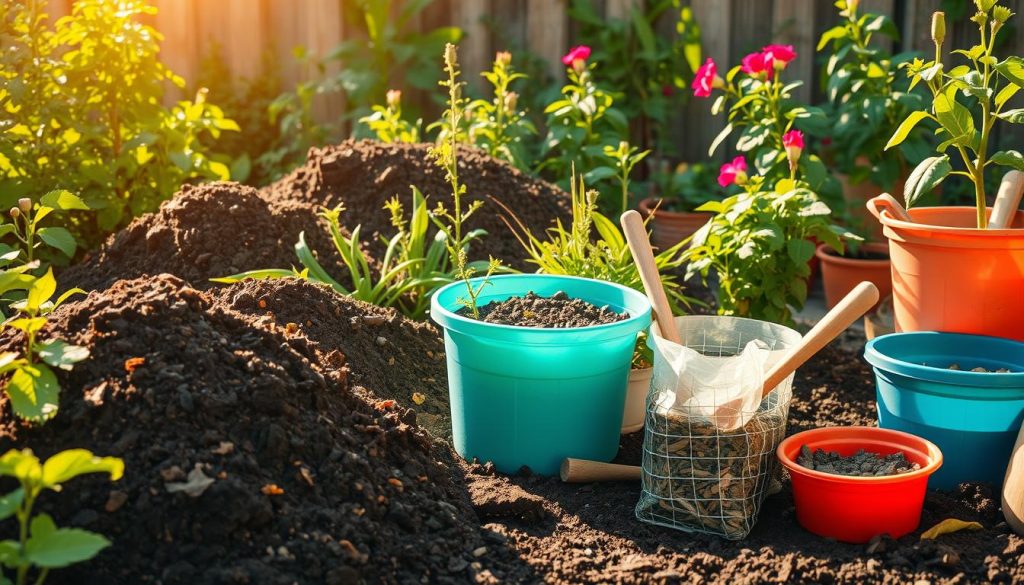
Using these common ingredients in your soil amendments can be both sustainable and affordable. Always mix different ingredients to create a balanced amendment that benefits your plants.
How to Prepare Homemade Compost
Making your own compost is a smart first step in creating DIY soil amendments. It involves mixing kitchen scraps and yard waste. Then, let them break down into a rich soil conditioner.
Using homemade compost can greatly improve your soil’s health and fertility. Adding these soil conditioners to your gardening routine makes your garden more sustainable and thriving.
Choosing the Right Materials
When picking materials for your compost, mix “green” items like food scraps and grass clippings with “brown” items like dried leaves and twigs. This mix is key for a healthy compost pile.
The Composting Process
The composting process needs regular turning to ensure oxygen flow and check moisture levels. A good compost pile smells earthy and feels crumbly. This shows the materials have broken down into a useful soil conditioner.
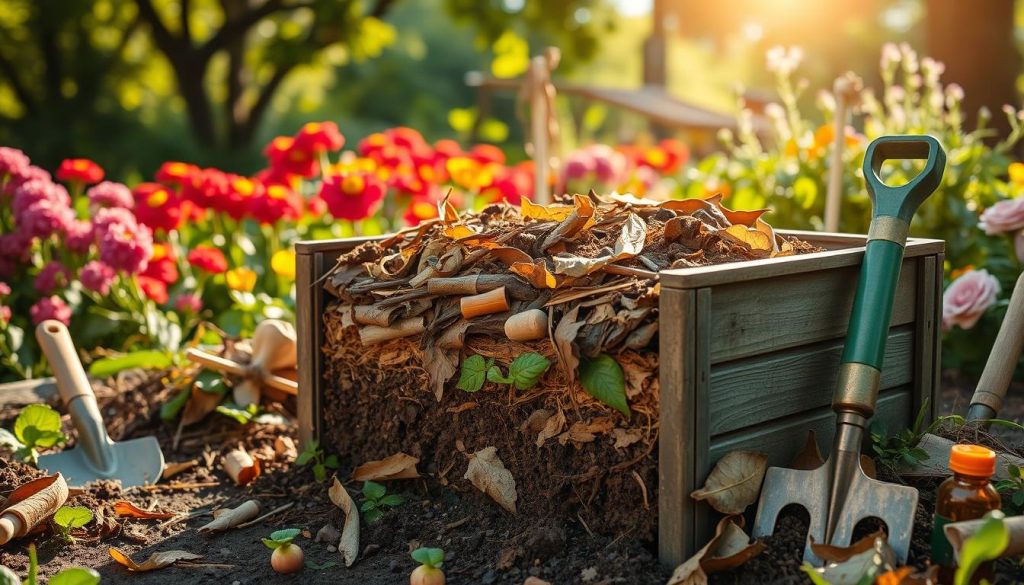
Troubleshooting Common Issues
Common composting problems include pests and bad smells. To fix these, make sure your compost has the right mix of materials. Also, turn it often to keep air flowing and stop anaerobic microorganisms from growing.
| Material | Category | Benefits |
|---|---|---|
| Kitchen scraps | Green | Rich in nitrogen |
| Dried leaves | Brown | High in carbon |
| Grass clippings | Green | Rich in nutrients |
Exploring Other DIY Soil Amendments
I’ve been trying out different DIY soil amendments and found organic additives really help. Using natural fertilizers is a great way to boost soil health.
Leaf mold, bone meal, and Epsom salt are some of the best DIY options. They improve plant growth and soil quality. Here’s why they’re good:
- Leaf mold: rich in nutrients and helps to improve soil structure
- Bone meal: adds vital nutrients like phosphorus and nitrogen
- Epsom salt: helps to improve soil drainage and reduces soil compaction
These additives and fertilizers have made my garden thrive. It’s now healthier and more sustainable. Plus, I use less synthetic fertilizers, which is better for the planet.
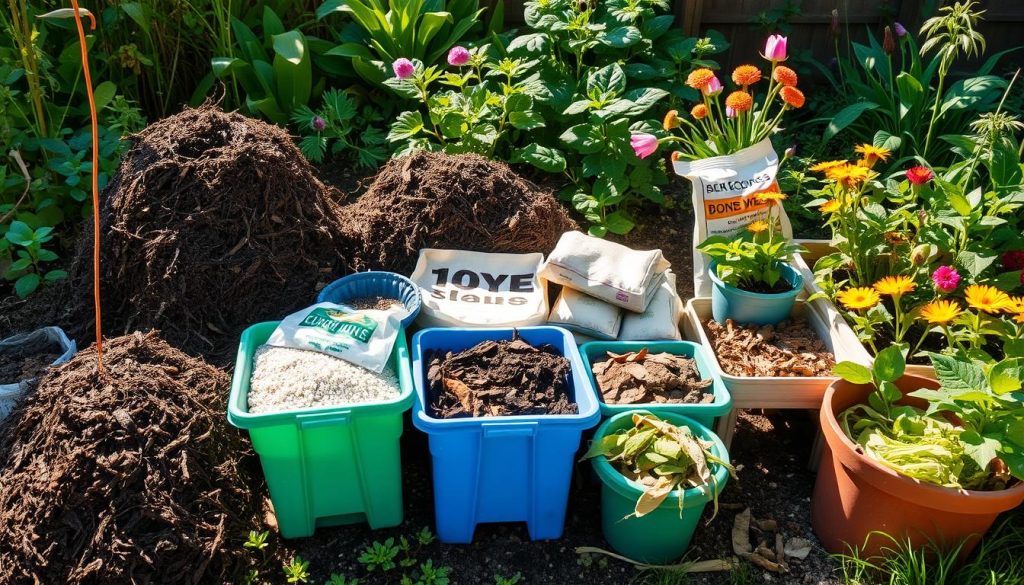
I’m looking forward to finding more DIY soil amendments. I want to keep improving my garden’s health and sustainability with organic and natural methods.
| DIY Soil Amendment | Benefits |
|---|---|
| Leaf Mold | Improves soil structure, rich in nutrients |
| Bone Meal | Adds vital nutrients like phosphorus and nitrogen |
| Epsom Salt | Improves soil drainage, reduces soil compaction |
How to Test Your Soil
To make your DIY soil amendments work, you need to know your soil’s current state. Soil testing kits are key for this. They help find your soil’s pH level, nutrient content, and more.
Understanding Soil Testing Kits
Soil testing kits have tools and instructions for soil samples. You can buy them online or at gardening stores. Pick a kit that fits your soil type and what you want to measure.
Interpreting the Results
After analyzing your soil, it’s time to understand the results. Look for pH level, nutrient content, and contaminants. This info helps choose the right DIY soil amendments for your soil.
Adjusting Your Amendments Accordingly
Use your soil test results to tweak your DIY soil amendments. For example, if your soil is too acidic, add lime to raise the pH. This way, you tailor your amendments to your soil’s needs.
Here are tips for adjusting your DIY soil amendments:
- Use organic materials like compost or manure to add nutrients to your soil
- Balance your soil’s pH level by adding lime or sulfur as needed
- Consider using cover crops to enrich your soil and reduce erosion
By following these steps and using the right DIY soil amendments, you can create a thriving and sustainable garden. Your garden will benefit from your sustainable soil amendment projects.
| Soil Type | pH Level | Nutrient Content |
|---|---|---|
| Clay | 6.0-7.0 | High in nutrients, but prone to waterlogging |
| Sandy | 6.0-7.0 | Low in nutrients, but well-draining |
| Loam | 6.0-7.0 | Balanced nutrient content, with good drainage |
Mixing and Applying Soil Amendments
When mixing and applying soil amendments, knowing the right ratios is key. Eco-friendly soil enhancers can greatly improve plant health and growth. With some DIY gardening tips, I’ve made my garden both beautiful and sustainable.
First, list the plants you want to amend and find their specific ratios. You can ask a gardening expert or look online for tips. Some plants need more nitrogen, while others require phosphorus or potassium. Using the correct ratios ensures your plants get the nutrients they need.
Here are some tips for mixing and applying soil amendments:
- Start with a small amount and gradually add more as needed
- Mix the amendments into the soil thoroughly to avoid burning the roots
- Apply the amendments at the right time, such as during the growing season or before planting
By following these tips and using eco-friendly soil enhancers, you can create a healthy and sustainable garden. Always follow DIY gardening tips and guidelines for the best results.
| Plant Type | Soil Amendment Ratio |
|---|---|
| Vegetables | 2:1:1 (nitrogen:phosphorus:potassium) |
| Fruits | 1:1:1 (nitrogen:phosphorus:potassium) |
| Flowers | 1:2:1 (nitrogen:phosphorus:potassium) |
My Favorite DIY Soil Amendment Recipes
I’ve tried many DIY soil amendment recipes and I’m eager to share my top picks. These recipes are budget-friendly and use natural ingredients to help plants grow well.
Simple Compost Recipe
This recipe turns kitchen scraps and yard waste into a nutrient-rich soil amendment. You’ll need:
- 2 cups of kitchen scraps (fruit and vegetable peels, tea bags, etc.)
- 1 cup of yard waste (dried leaves, grass clippings, etc.)
- 1 cup of water
Homemade Fertilizer Mix
This mix combines natural fertilizers for essential nutrients. It includes:
- 1 cup of bone meal
- 1 cup of alfalfa meal
- 1 cup of kelp meal
Quick Leaf Mold Preparation
Leaf mold is great for gardens and easy to make at home. Just shred fallen leaves and mix with water for a nutrient-rich amendment.
| Recipe | Ingredients | Benefits |
|---|---|---|
| Simple Compost Recipe | Kitchen scraps, yard waste, water | Nutrient-rich soil amendment |
| Homemade Fertilizer Mix | Bone meal, alfalfa meal, kelp meal | Essential nutrients for plant growth |
| Quick Leaf Mold Preparation | Fallen leaves, water | Nutrient-rich soil amendment |
The Impact of DIY Amendments on My Garden
Using DIY soil amendments in my garden has made a big difference. My plants are healthier and more productive. This method is good for the environment and saves money on store-bought fertilizers.
Improved Plant Health
Some of the benefits I’ve seen include:
- Increased resistance to diseases and pests
- Improved nutrient uptake and utilization
- Enhanced root development and plant growth
Increased Yields and Growth
My DIY soil amendments have also led to:
- Higher yields and better fruit quality
- Faster growth rates and more vigorous plants
- Improved soil structure and water retention
Environmental Benefits
Using DIY soil amendments helps the environment. It reduces my need for synthetic fertilizers. This makes my garden a better place for both plants and the environment.
Overall, I’m very happy with DIY soil amendments. I highly recommend them to anyone wanting a healthier garden. It’s good for the environment and supports sustainable projects.
| Benefits of DIY Soil Amendments | Results |
|---|---|
| Improved Plant Health | Increased resistance to diseases and pests, improved nutrient uptake and utilization |
| Increased Yields and Growth | Higher yields and better fruit quality, faster growth rates and more vigorous plants |
| Environmental Benefits | Reduced reliance on synthetic fertilizers, creation of a more balanced and diverse ecosystem |
Tips for Maintaining Healthy Soil Year-Round
Keeping your soil healthy is a long-term effort. But with the right steps, your garden can flourish all year. As a DIY gardener, I’ve found that seasonal changes, rotating amendments, and trying new things are crucial.
Seasonal Considerations
Every season has its own soil needs. In spring, I add nutrients and get the soil ready for plants. Summer is about watching moisture and adjusting water. Autumn is for adding leaves and organic matter to strengthen the soil for winter.
Rotating Amendments
I change the eco-friendly soil enhancers I use with the seasons. This keeps my plants getting a wide range of nutrients and microorganisms. By mixing up my gardening tips, my soil stays healthy.
Continuing to Learn and Experiment
Soil health is always changing, and I love to learn more. I keep up with new research and try new things in my garden. By experimenting, I find the best mix for my soil and conditions.

